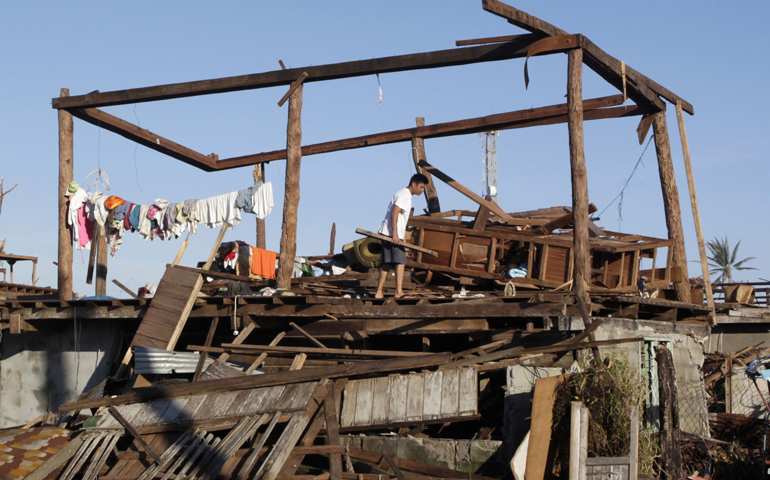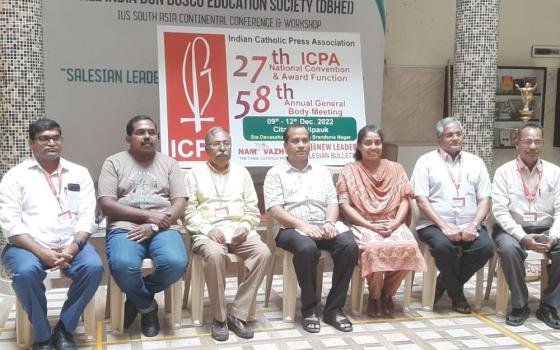
A man stands inside a frame of his house Tuesday after it was destroyed a week earlier by 120-mph winds in the coastal town of Cateel, Philippines. Struggling to find adequate shelter to escape the heat of the midday sun, survivors of Typhoon Bopha scavenged whatever debris they could to build makeshift housing across storm-ravaged provinces of the Philippines. (CNS/Reuters/Erik De Castro)
Struggling to escape the heat of the midday sun, survivors of Typhoon Bopha scavenged whatever debris they could to build makeshift shelters across storm-ravaged provinces of the southern Philippines.
From the coastal communities of Boston and Cateel in Davao Oriental province to the inland town of New Bataan in Compostela Valley province, little remained standing from the 120-mph winds and flash flooding of Dec. 4 that left more than 700 dead and almost 900 missing across the island of Mindanao.
Jennifer Hardy, regional information officer for Asia for Catholic Relief Services, told Catholic News Service on Tuesday that emergency workers and aid agencies were having a difficult time reaching isolated communities along the coast a week after the storm because the destruction was so severe.
"People have a lot of unmet needs," Hardy said from the city of Tagam after touring the coastal region Monday. "The biggest need is emergency shelter. People are trying to piece together ramshackle shelter from the debris.
"The people are out in the sun all day. There's a lack of shade. I saw people lined up next to a power pole, a whole family of six people in a row, to stand in the shade of that pole because it is so hot in the sun," she said.
In interviews with survivors, Hardy said people described harrowing experiences in which emergency shelters were destroyed and, despite the howling wind, people could hear the sound of the trees in coconut groves snapping.
"The scenery on the hillsides looks very similar to a forest fire in the United States west. The only things left standing is the trunk of a tree. If they are not broken off, then all the branches are gone," she said.
In New Bataan, a city surrounded by banana plantations in the fertile Compostela Valley, a massive mudslide took out thousands of homes, schools and government buildings. Even evacuation shelters were damaged or destroyed, said Hardy, who visited the city Saturday and Sunday.
"There's mud everywhere," she said.
In one neighborhood, Hardy described a scene of utter destruction as homes were buried under mud and boulders swept down from the surrounding mountains by floodwater,
"The homes that were not hit by the mudslide, they're pretty severely damaged. Some people are camping out in their homes. Others are staying in evacuation centers. For the homes hit by the mudslide, you can't even tell the home was even there."
Hardy also recalled a conversation with 6-year-old Maria Leon, who was in an evacuation center with her father, Olimpio. The storm claimed the lives of the girl's grandparents and several cousins.
"She's pretty shy. But she did talk about wondering when she will be able to go back to school because her school was knocked down by the mudslide," Hardy said.
Olimpio Leon was concerned about getting sleeping mats so that he and his daughter would not have to sleep on mud-caked concrete floors, made worse by the constant in-and-out of evacuees.
"They honestly have nothing left. They escaped with the clothes on their back," she said.
Catholic Relief Services planned to begin distributing sleeping mats, cooking utensils, food and water Dec. 13. Hardy said CRS workers were coordinating aid delivery with other agencies.
Hardy said the situation in the rural communities was far different from last December's Typhoon Washi, which left 1,200 dead in flash flooding in parts of Cagayan de Oro, a city of 602,000 in northern Mindanao.
"Here it's so spread out," she said. "There are very rural areas. I just don't know how that's going to shake out in trying to get aid to tiny, spread-out towns."
Meanwhile, the United Nations said Dec. 10 it needed to raise an additional $65 million for storm survivors, reported the Asian church news agency UCA News.
Luisa Carvalho, U.N. resident coordinator in Manila, said an initial $35.5 million had been requested to support relief and rehabilitation but that the extra funding was needed to help those worst affected -- nearly half a million people -- in Compostela Valley and Davao Oriental provinces.
The government has allocated $195.3 million for the early recovery effort.
"Health problems are growing in addition to the fact that we need to address their food needs," said Gov. Arturo Uy of Compostela Valley.
About 70 percent of the people in Compostela Valley have been affected by the disaster, he said.
More than 1,900 people were injured because of the typhoon, which caused an estimated $171 million in damage, said the Philippine government.




